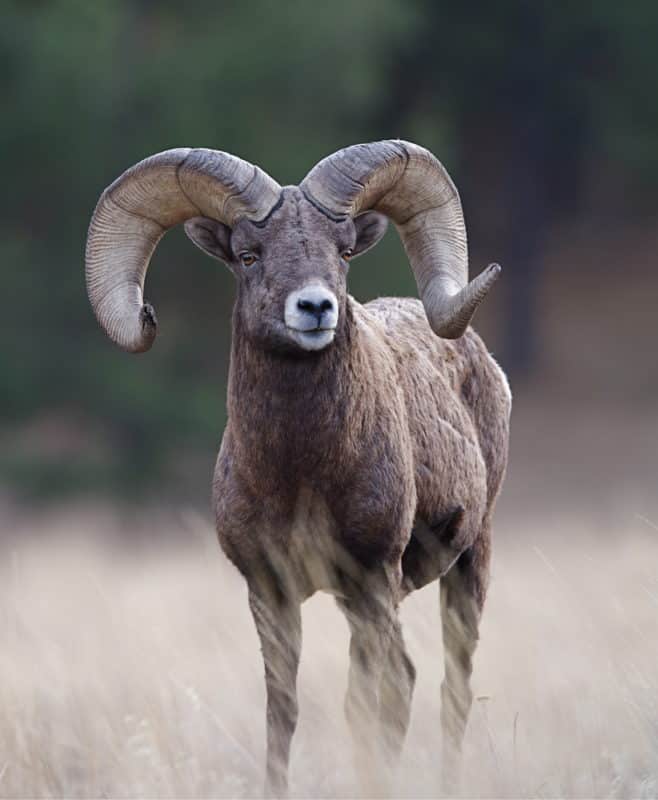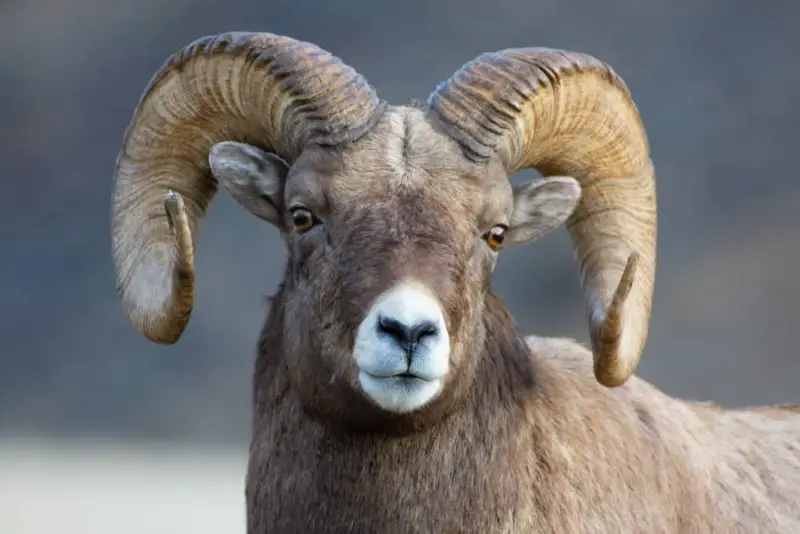North American wild sheep are classified into two major species, bighorn sheep and thinhorn sheep. Both sexes of wild sheep have horns. Ram’s horns are heavier and curl around their faces. Ewe horns, on the other hand, are lighter and only curl slightly. The characteristics of the ram’s horns in each species are a determining factor in their species identification. The horns of a Bighorn ram curl back above and around the ears; then the curl continues down and up past their jaws. They are thick at the base and taper in circumference along with the extent of the horn. The horns of a Thinhorn are similar in construction and appearance to that of a Bighorn, except that they are thinner in appearance and are more yellowish in color compared to the dark brown of a Bighorn.
Each of the wild sheep species is in turn divided into two major subspecies each. We’ll talk more about each subspecies, their characteristics, life histories, and the range they live in later in the article.
The Thinhorn Sheep
Thinhorn (Ovis Dalli) sheep reside in Canada and Alaska. They are further classified into smaller races or subspecies, Stone’s sheep (Ovis Dalli Stonei) and Dall’s sheep (Ovis Dalli Dalli). The thinhorn sheep range extends through Alaska, British Columbia, the Yukon, and the North West Territories.

Stone Sheep
The first thinhorn sheep we’ll talk about is the Stone Sheep. The stone sheep’s color variations range from almost white to slate gray to chocolate brown and even black. In most cases, their heads and necks are lighter colored than their body. They have a white muzzle, belly, and rump patch. Their tails are black. Animals of various colors may be found within the same group. Their horns range from light brown to dark brown. They are about forty inches tall at the shoulder and weigh about 200 pounds. In extreme cases, a large Stone ram can weigh up to 250 pounds.
The Stone Sheep’s territory lies exclusively in Canada. The largest portion of it lies in British Columbia, north of the Peace River valley. Along with British Columbia, the southern tip of the Yukon Territory has some Stone Sheep. However, researchers have genetically proven that a large portion of the animals in the Yukon that was thought to be Stone Sheep are actually dark-colored Dall Sheep.
There are approximately 18500 Stone Sheep in the wild.

Dall Sheep
Most Dall Sheep are white to off-white in color. Rams can stand three and a half feet at the shoulder and weigh up to 160 pounds. Dall rams are known for their curled massive horns. The females have shorter, slender, and slightly curved horns.
Adult Dall rams move in bachelor bands and do not associate with the ewes after the mating season in late November and early December. Lambs are born in late May or early June. To get out of the reach of most predators, Ewes seek out the most rugged cliff terrain they can find to go and give birth to their lamb. They remain there until the lamb can travel. The first two months after the lambs are born are always very dangerous due to predators. These animals mostly live above the timberline and graze on grasses, lichens, moss, and other plants in this environment. They seek out wind-blown ridges where frozen dry grass and sedge stems have been exposed to graze on in the winter.
Dall Sheep Range
Dall Sheep have ranged in Alaska, British Columbia, the Yukon, and the Northwest Territories. British Columbia’s Dall Sheep range lies in its northwest corner. In the Yukon, Sheep Mountain in Kluane National Park is a good area to view Dall Sheep. The Mackenzie and Richardson Mountains in the Northwest Territories are Dall Sheep range. In Alaska, they live in the regions surrounding the Tok river, the Chugach Mountains, the northern Wrangell Mountains, the Eastern Brooks Range, and the Alaska range east of the Nenana River.
There are approximately 100,000 Dall Sheep in the wild.
The Bighorn Sheep
Bighorn sheep have two subspecies. The first is Bighorn sheep. The second is Desert Bighorn Sheep. The Bighorn Sheep subspecies are divided into Rocky Mountain Bighorn sheep and the Sierra Nevada Bighorn. Rocky Mountain Bighorn Sheep (Ovis canadensis) occupy the Northwestern United States and the Canadian Rocky Mountains. The Sierra Nevada Bighorn (Ovis canadensis sierrae) inhabits the mountains from the California Coastal Ranges to the Sierra Nevada through Transverse Ranges. The other Bighorn species is the Desert Bighorn Sheep (Ovis canadensis nelsoni). They range in the desert country of the Southwestern United States and northwestern Mexico.

Rocky Mountain Bighorn Sheep
Rocky Mountain Bighorn sheep are the largest of the Northern American sheep. They’re dark brown to grey with white on the hind legs, rump patch, and muzzle. Their coats are lighter in the Spring and darker in the summer months. The rams have close-to-the-face horns that are tightly curled. Ewes have short, slightly curled horns. Rams weigh up to 300 pounds and are and three feet tall at the shoulders. Their scientific name is Ovis Canadensis. They have a broad vision due to the wide set of eyes they have.
Rocky Mountain Bighorn Sheep live in the Rocky Mountains of the western United States and Canada.
Except for during the mating season, Rocky Mountain rams and ewes live apart in bands segregated by gender and age. The rut occurs from October through December. Rams fight for dominance and the right to breed with ewes. In fighting dominance, rams rare up on their hind legs, lunge at each other at speeds up to forty miles per hour, and smash their heads together until one of the combatants gives up and walks away. The loud report of their horns crashing together can be heard up to a mile away.
Lambs are born in the spring and can walk immediately after birth. Young rams leave their mother’s band at about four years of age. In the summer, they feed on grass, and in winter, they feed on shrubs. . Their lifespan ranges to about ten years.
Sierra Nevada Bighorn Sheep (Ovis Canadensis Sierra)
Sierra Nevada Bighorn sheep are light to dark brown with a dark tail and white rump. They have adhesive hooves to offer grip in steep and rocky terrain. The rams weigh around 220 pounds, whereas ewes weigh about 155 pounds. They have an average lifespan of eight to twelve years.
The Sierra Nevada Bighorn sheep are social animals. They move in groups depending on their age and gender, and the season. Rams and ewes come together during the mating season, extending from mid-October through mid-December and separate after that. During mating, season rams engage in battles for dominance. Dominant rams get to do the breeding. Ewes carry their lambs for six months and typically deliver anywhere from mid-April through mid-June. They wean their lambs when they’re around five months old.
The Sierra Nevada are grazers. They primarily feed on woody vegetation, forbs, and grasses.

Desert Bighorn Sheep
Desert Bighorn Sheep or Ovis Canadensis nelsoni has white fur around the belly, muzzle, and rump. They have brown chocolate fur with a muscular body. The rams have curved large horns, with the females having slight curvature in their short horns. Rams weigh up to 250 pounds. Ewes are somewhat smaller.
These creatures inhabit the desert country of the Great Basin and the Colorado Plateau, the Mojave Desert, and the Sonoran and Chihuahuan Deserts of Mexico.
Desert Bighorns Are At Home In Their Environment
Desert Bighorns are uber adapted to life in the arid desert southwest. They can go from three to seven days without drinking. During these long intervals without water, they depend on the plants they eat to provide them with life-sustaining moisture. When they have occasion to drink, they will take in up to two gallons of water. This completely rehydrates them within minutes. They socially move in bands of about 15 sheep. However, rams and ewes do not intermingle except during the rut extends from mid-July through November.
Some Things All North American Wild Sheep Have In Common
- Wool– All wild sheep have a short fine layer of wool which in turn is covered by a layer of hair. Their wool insulates them from temperature extremes. Unlike domestic sheep, wild sheep never need to be sheered. They shed both their hair and their wool and grow new coverings respective to the season.
- Horns– The horns on all four of the major subspecies are very similar. Rams have larger, fully curling horns while ewe’s horns are lighter. Shorter and only curl slightly.
- Sociality– Common among all four subspecies is that they group together in small bands according to gender and age. Ewes and lambs do not mingle with mature rams outside of mating season.
- Headbutting to determine dominance– During their respective mating seasons, headbutting is common to all of North America’s wild sheep. Rams do this to determine dominance. The dominant ram is the one that gets to do the breeding. Rams will rear up on their hind legs and lunge at each other, smacking their heads together at a high rate of speed. A contest between two rams sometimes goes on for hours until one gives up and walks away. These wild sheep have a great resiliency to absorbing the shock of innumerable head-to-head collisions; consequently, scientists believe that sheep hold answers to avoiding human brain injury.
In Conclusion
There are two species and four major subspecies of North American Wild Sheep. The information in this article will help you identify what kind of sheep you’re looking at, and you’ll also be able to tell your friends a little bit about them.
Recent Posts
The only venomous snakes in Washington State are Northern Pacific Rattlesnakes. The Northern Pacific Rattlesnake (Crotalus oreganus oreganus) is a sub-species of the Western Rattlesnake. Anyone...
Skunks are not classified as true hibernators. But they go into a state of torpor when the weather gets cold. Skunks are light sleep hibernators, along with opossums, bears, and raccoons. ...

